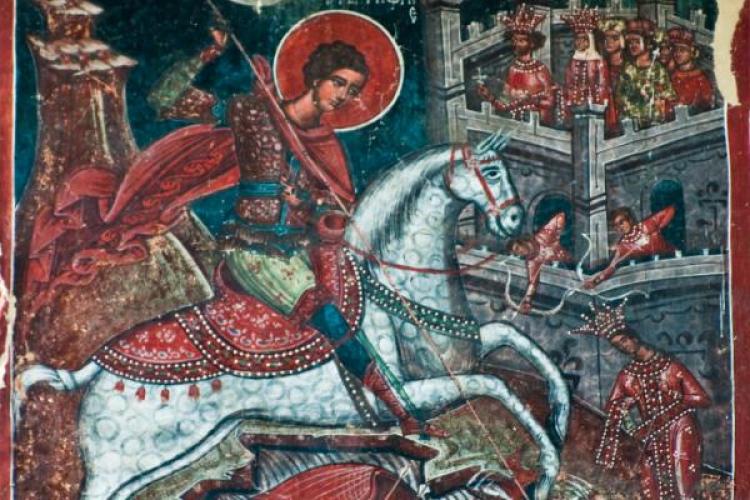Making a crossword:
1. Think about the words (20) that you are going to use.
2. How are you going to distrtibute the letters (words) in the squares.
3. Make clues (sentences, drawings, part of the answer...)
Material:
- A2, poster board
- Colours, ruler...
Here you can find some activities to know about Saint George's day:
clic 1
clic 2
St. George's Day in the United Kingdom
St George's Day in England remembers St George, England's patron saint. The anniversary of his death, which is on April 23, is seen as England's national day. According to legend, he was a soldier in the Roman army who killed a dragon and saved a princess.
Celebrate St George's Day
St George's Day used to be a national holiday in England. It is now
an observance that is celebrated with parades, dancing and other
activities. Flags with the image of St George's cross are flown on some
buildings, especially pubs, and a few people wear a red rose on their
lapel. Church services on the Sunday closest to April 23 often include
the hymn 'Jerusalem', written by the poet William Blake. The words
describe a supposed visit to Glastonbury, England, by Jesus Christ
during his youth.
Public Life
April 23 is not a public holiday. Schools, stores, post offices,
businesses and other organizations are open as usual. Public transport
services run to their usual timetables.
About St George's Day
St George was born sometime around the year 280 in what is now
Turkey. He was a soldier and rose up through the ranks of the Roman
army, eventually becoming a personal guard to the Emperor Diocletian. He
was executed for being a Christian on April 23, 303, and is buried in
the town of Lod in Israel.
St George is most widely known for slaying a dragon. According to legend, the only well in the town of Silene was guarded by a dragon. In order to get water, the inhabitants of the town had to offer a human sacrifice every day to the dragon. The person to be sacrificed was chosen by lots. On the day that St George was visiting, a princess had been selected to be sacrificed. However, he killed the dragon, saved the princess and gave the people of Silene access to water. In gratitude, they converted to Christianity. It is thought that the dragon represents a certain type of pagan belief that included the sacrifice of human beings.
St George's Day was once celebrated as widely as Christmas. But the
celebrations waned by the end of the 18th century after England had
united with Scotland on May 1, 1707. In recent times, there has been a
push, involving campaigns and petitions, to make the day a public
holiday in England.St George is most widely known for slaying a dragon. According to legend, the only well in the town of Silene was guarded by a dragon. In order to get water, the inhabitants of the town had to offer a human sacrifice every day to the dragon. The person to be sacrificed was chosen by lots. On the day that St George was visiting, a princess had been selected to be sacrificed. However, he killed the dragon, saved the princess and gave the people of Silene access to water. In gratitude, they converted to Christianity. It is thought that the dragon represents a certain type of pagan belief that included the sacrifice of human beings.
St George is the patron saint of a number of other places, such as Bulgaria, Ethiopia, Georgia, Greece, Portugal and Russia. He is also remembered in some regional holidays, such as in the province of Newfoundland and Labrador in Canada and among the Gorani people who live in a mountainous area in the Balkans and were converted to Islam many centuries ago, but still observe St George's Day. Around the world, a number of days are devoted to St George, including April 23 and dates in November and December of the Gregorian calendar.
Symbols
The most widely recognized symbol of St George's Day is St George's cross. This is a red cross on a white background, which is often displayed as a flag. It is used as England's national flag, forming part of the Union Flag, the national flag of the United Kingdom of Great Britain and Northern Ireland. Saint George's cross was originally the flag of the maritime Republic of Genoa. Around 1190, the King of England started paying the Doge of Genoa to protect ships originally from the city of London and the rest of England that sailed in the Mediterranean.During the crusades in the 1100s and 1200s, English knights used St George's cross as part of their uniform. It has been the official flag of England for centuries, but the Union Flag, a combination of St George's cross, St Andrew's cross and St Patrick's cross, is the national flag of the United Kingdom. Now Saint George's cross is used as a national symbol by fans of the English national football, rugby and cricket teams. At international matches, flags and scarves bearing this cross are worn and people paint it on their faces. It is also has a prominent place on the arms of the City of London and the flags of the city of
No comments:
Post a Comment